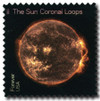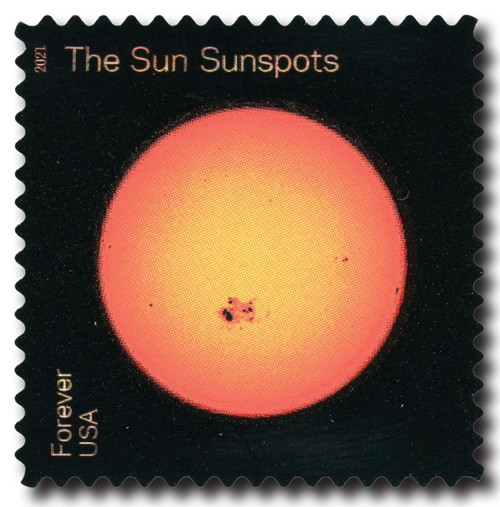
# 5603 - 2021 First-Class Forever Stamp - Sun Science: Coronal Loops
US #5603
2021 Coronal Loops – Sun Science
- Pictures coronal loops on the sun
- One of 10 stamps in the Sun Science set
Stamp Category: Commemorative
Set: Sun Science
Value: 55¢ First Class Mail Rate (Forever)
First Day of Issue: June 18, 2021
First Day City: Greenbelt, Maryland
Quantity Issued: 18,000,000
Printed by: Banknote Corporation of America
Printing Method: Flexographic, Foil Stamping
Format: Panes of 20
Tagging: Phosphor, block tag
Why the stamp was issued: To showcase the powerful and mysterious science behind the functioning of our sun.
About the stamp design: Pictures a colorized images from NASA’s Solar Dynamics Observatory of coronal loops on the sun. According to NASA, the color of this stamp represents an image of the sun as viewed with “extreme ultraviolet wavelength 171 Angstroms.”
First Day City: The First Day of Issue Ceremony was held at Greenbelt Main Post Office. It was originally to be held at the NASA Goddard Space Flight Center, but was moved due to observance of the Juneteenth Federal Holiday and the facility being closed.
About the Sun Science set: Includes 10 stamp designs picturing different details of our sun along with phenomena associated with it. Each design pictures a colorized image from NASA’s Solar Dynamics Observatory. The different colors represent a different wavelength that reveals or highlights a particular aspect of our sun.
History the stamp represents: The Sun is made up of a number of different parts. Perhaps one of the most well known is the corona. This word is Latin for “crown” and refers to the layer of plasma that surrounds the Sun. (You may have heard of it in relation to total solar eclipses – the best time to view the corona.)
Scientists have measured the Sun’s corona as extending hundreds of thousands of miles into space. They’ve also estimated temperatures of over one million degrees Kelvin. That’s more than 1.8 million degrees Fahrenheit. Interestingly, this makes the Sun’s corona hotter than its surface. To give some perspective on what this means for our solar system, let’s take a look at Mercury. This tiny planet is 35 million miles away from the sun and still experiences temperatures of up to 800 degrees Fahrenheit during the day!
Much about the Sun’s corona is still a subject of mystery for scientists. However, we do know that the far edges of the corona are pulled away from the Sun by something called magnetic flux. This generates solar wind, which can sometimes reach Earth. Thankfully, our atmosphere protects us from the harmful effects of this intense solar radiation. We do, however, get something positive from this radiation – the beautiful aurora events that take place at Earth’s North and South Poles.
US #5603
2021 Coronal Loops – Sun Science
- Pictures coronal loops on the sun
- One of 10 stamps in the Sun Science set
Stamp Category: Commemorative
Set: Sun Science
Value: 55¢ First Class Mail Rate (Forever)
First Day of Issue: June 18, 2021
First Day City: Greenbelt, Maryland
Quantity Issued: 18,000,000
Printed by: Banknote Corporation of America
Printing Method: Flexographic, Foil Stamping
Format: Panes of 20
Tagging: Phosphor, block tag
Why the stamp was issued: To showcase the powerful and mysterious science behind the functioning of our sun.
About the stamp design: Pictures a colorized images from NASA’s Solar Dynamics Observatory of coronal loops on the sun. According to NASA, the color of this stamp represents an image of the sun as viewed with “extreme ultraviolet wavelength 171 Angstroms.”
First Day City: The First Day of Issue Ceremony was held at Greenbelt Main Post Office. It was originally to be held at the NASA Goddard Space Flight Center, but was moved due to observance of the Juneteenth Federal Holiday and the facility being closed.
About the Sun Science set: Includes 10 stamp designs picturing different details of our sun along with phenomena associated with it. Each design pictures a colorized image from NASA’s Solar Dynamics Observatory. The different colors represent a different wavelength that reveals or highlights a particular aspect of our sun.
History the stamp represents: The Sun is made up of a number of different parts. Perhaps one of the most well known is the corona. This word is Latin for “crown” and refers to the layer of plasma that surrounds the Sun. (You may have heard of it in relation to total solar eclipses – the best time to view the corona.)
Scientists have measured the Sun’s corona as extending hundreds of thousands of miles into space. They’ve also estimated temperatures of over one million degrees Kelvin. That’s more than 1.8 million degrees Fahrenheit. Interestingly, this makes the Sun’s corona hotter than its surface. To give some perspective on what this means for our solar system, let’s take a look at Mercury. This tiny planet is 35 million miles away from the sun and still experiences temperatures of up to 800 degrees Fahrenheit during the day!
Much about the Sun’s corona is still a subject of mystery for scientists. However, we do know that the far edges of the corona are pulled away from the Sun by something called magnetic flux. This generates solar wind, which can sometimes reach Earth. Thankfully, our atmosphere protects us from the harmful effects of this intense solar radiation. We do, however, get something positive from this radiation – the beautiful aurora events that take place at Earth’s North and South Poles.













